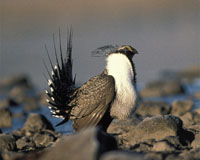| . |  |
. |
Washington DC (SPX) Nov 29, 2010 Koalas may be the pickiest marsupials around: They evolved to feed almost exclusively on the leaves of Eucalyptus trees, and they are highly selective when it comes to which species and even which individual trees they visit. When the furry leaf-eater settles on a particular tree, it relies on a number of factors, including taste, to make its selection. In a study published in the November issue of Ecology, a journal of the Ecological Society of America (ESA), researchers used koala feeding preferences to design a new method that could help ecologists and conservationists map habitats. Ben Moore and colleagues from the Australian National University and the Macaulay Land Use Research Institute in Scotland collected and analyzed leaves from all the trees available to koalas in a Eucalyptus woodland using a near-infrared spectroscopic model. To define "palatability" in koala terms, the researchers tested leaves on captive koalas and recorded how much they ate: They found that the koalas ate less foliage when it contained lots of lipid-soluble phenolic chemicals known as formylated phloroglucinol compounds (FPCs). The researchers then tracked koala tree visits in a Eucalyptus woodland to show that tree preferences of wild koalas could be predicted using the taste preferences of the captive koalas. The researchers also determined the chemical composition of the trees' leaves and other factors such as tree size and neighborhood quality, or how attractive each tree's neighbors were to koalas. Specifically, koalas spend more time in large trees; however, the individual trees they prefer depend on the taste of the leaves and the "neighborhood" in which the tree is growing. Although tree size and taste are most important to the koalas, the researchers found that trees were visited more often if they were surrounded by smaller, less palatable trees or by larger, more palatable trees. Moore and colleagues explained that trees surrounded by smaller, unpalatable trees were probably more attractive by comparison. At the other extreme, trees surrounded by other large, palatable trees were visited more frequently because koalas were attracted to these high-quality areas. "This method uses a new technique to combine our understanding of animal behavior with the chemical, spatial and physical aspects of the environment to make a map of koala habitat, as koalas see it," said Moore. "Our approach can aid ecologists in tracking and examining the presence or absence of animal populations in different areas-and it can measure plants' susceptibility to herbivory-by determining the quality and value of a habitat from the herbivore's point of view."
Share This Article With Planet Earth
Related Links Ecological Society of America Darwin Today At TerraDaily.com
 Sage-Grouse Western Habitat Map Completed
Sage-Grouse Western Habitat Map CompletedWashington DC (SPX) Nov 29, 2010 Secretary of the Interior Ken Salazar has announced the completion of a breeding bird density map for the greater sage-grouse by the Bureau of Land Management in coordination with the Western Association of Fish and Wildlife Agencies, the U.S. Fish and Wildlife Service, and the Natural Resources Conservation Service. The map identifies important range-wide focal areas having high density o ... read more |
|
| The content herein, unless otherwise known to be public domain, are Copyright 1995-2010 - SpaceDaily. AFP and UPI Wire Stories are copyright Agence France-Presse and United Press International. ESA Portal Reports are copyright European Space Agency. All NASA sourced material is public domain. Additional copyrights may apply in whole or part to other bona fide parties. Advertising does not imply endorsement,agreement or approval of any opinions, statements or information provided by SpaceDaily on any Web page published or hosted by SpaceDaily. Privacy Statement |